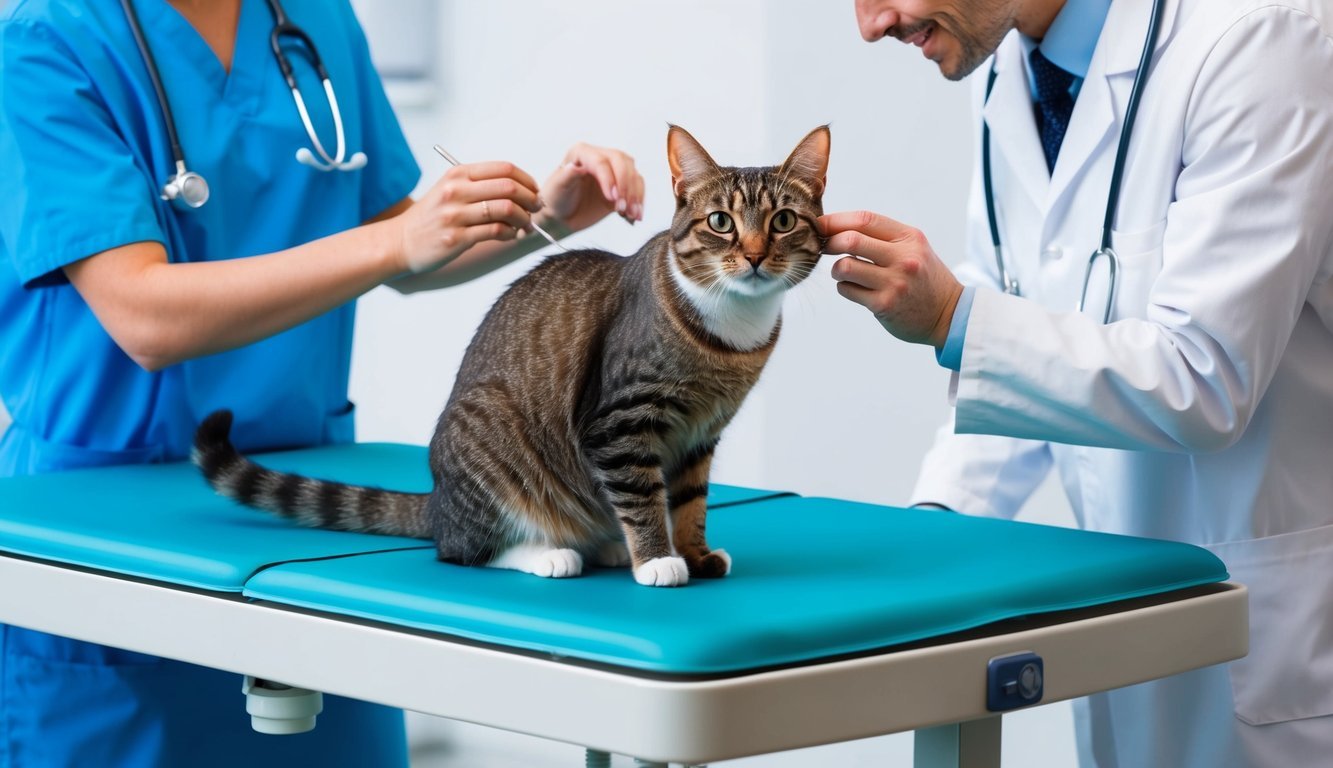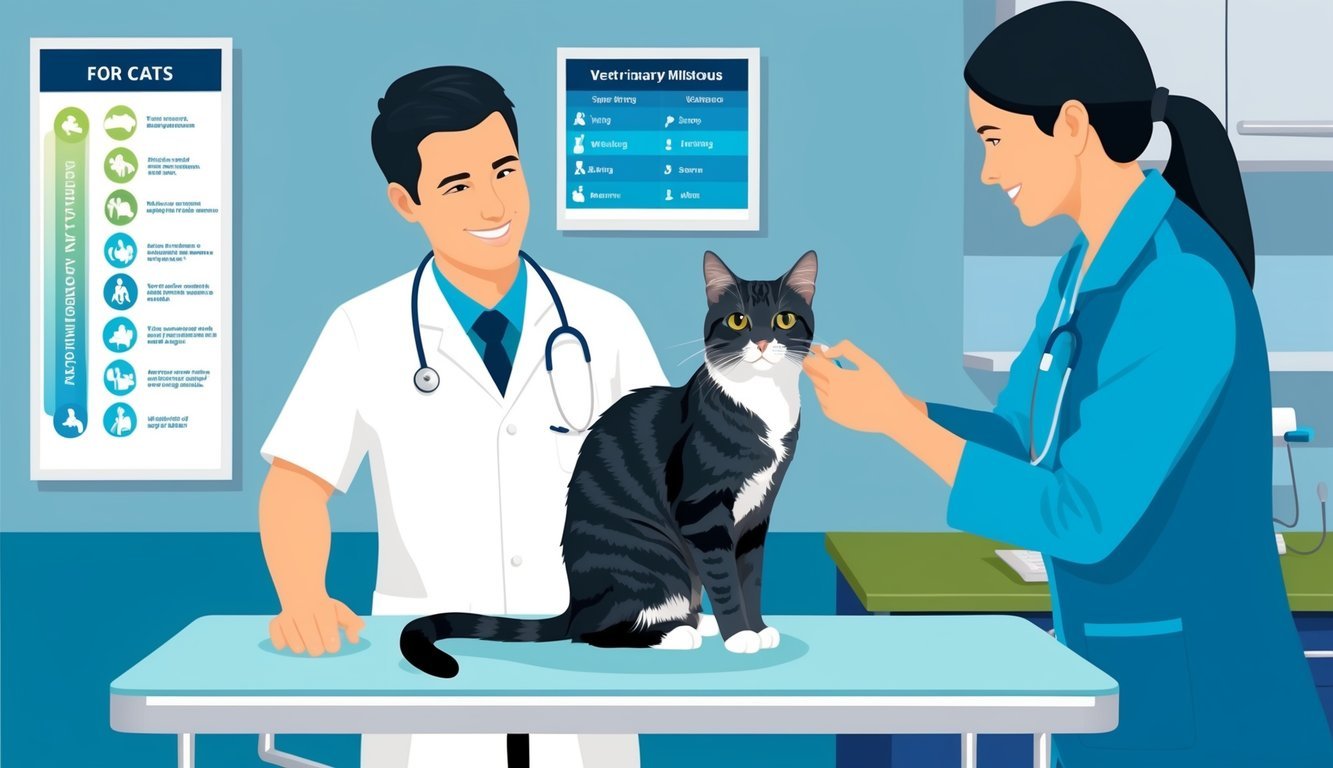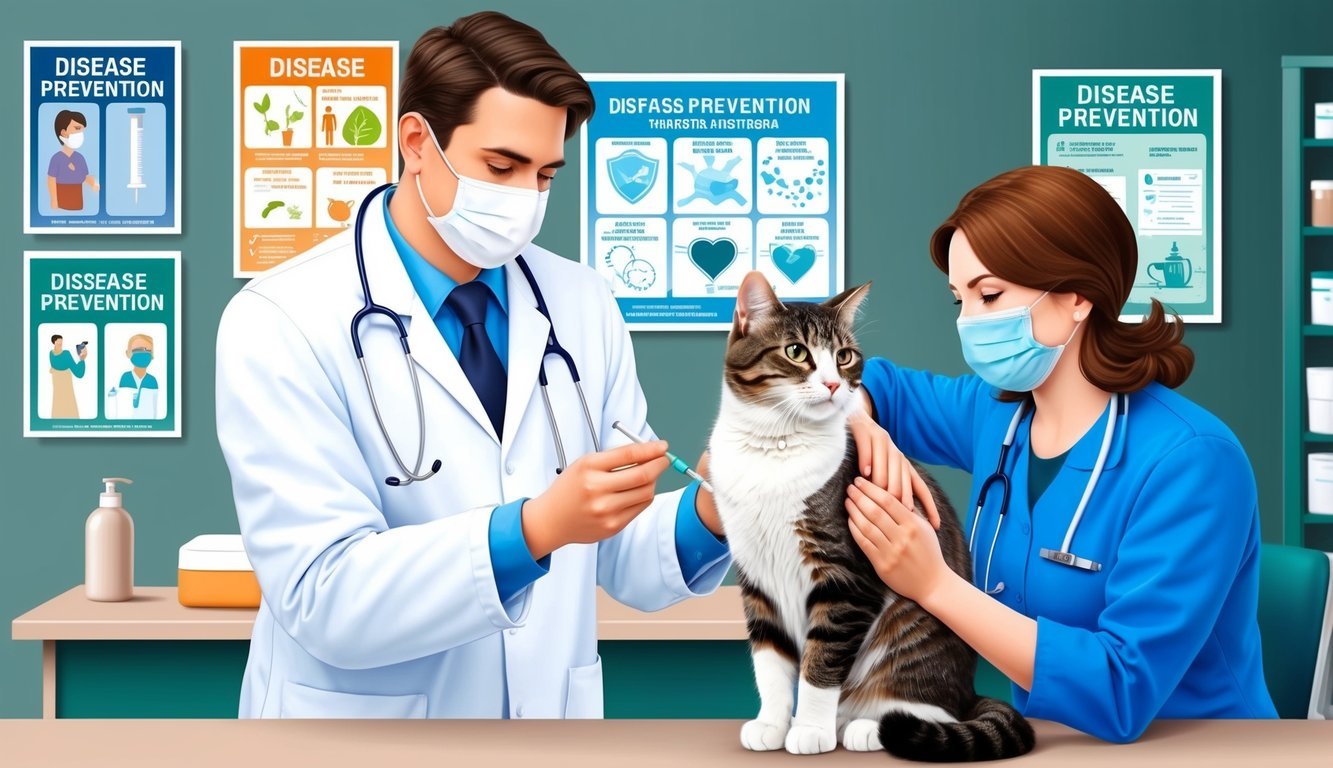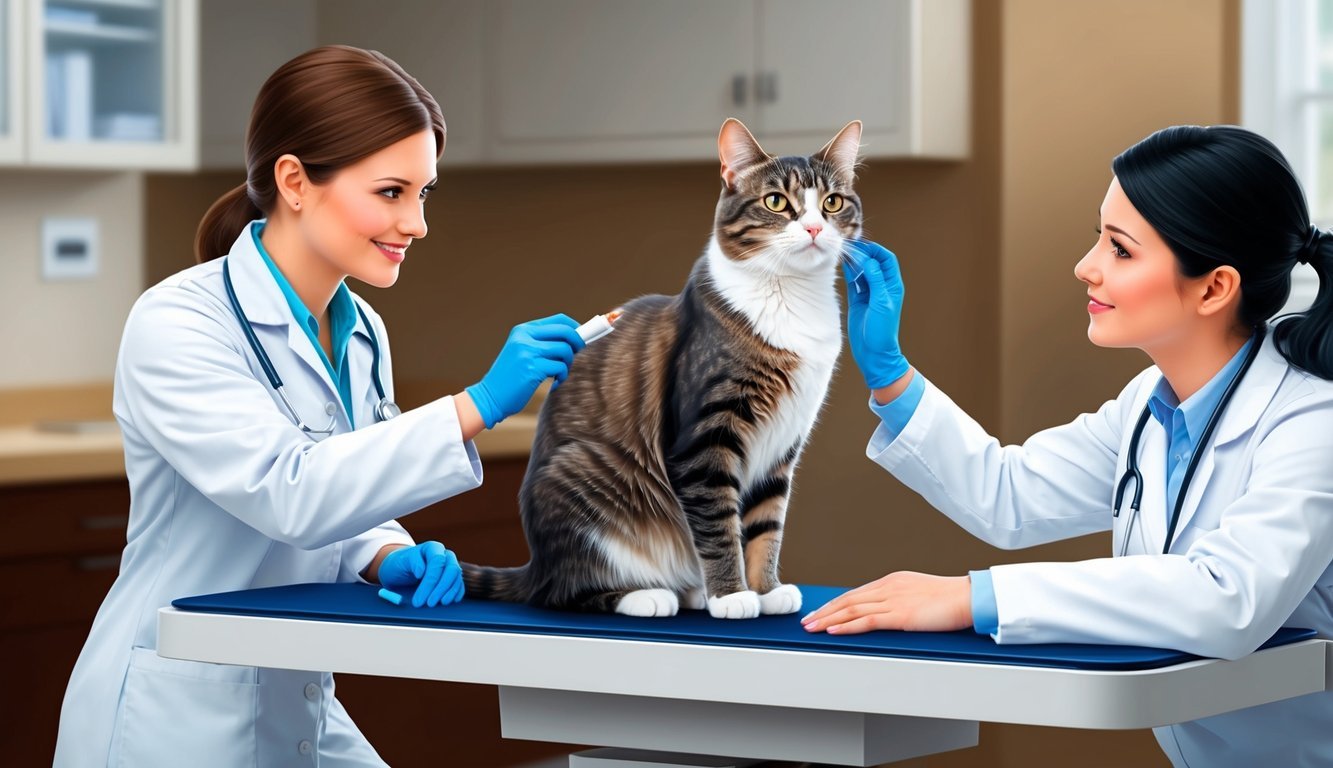When it comes to your cat’s health, regular veterinary visits are crucial for ensuring they live a long and happy life. Adult cats typically need to see the vet at least once a year, while senior cats or those with existing health issues may require check-ups every six months. These visits not only allow for vaccinations and wellness exams but also help catch any potential health problems early.
Understanding your cat’s specific health care needs is essential.
Kittens, adults, and senior cats have different requirements, ranging from regular vaccinations to monitoring for age-related conditions.
By being aware of the frequency of visits based on your cat’s age and health status, you play a key role in their overall well-being.
Staying proactive about your cat’s health can prevent many issues and ultimately save you time and money.
Regular check-ups are a vital part of keeping your feline friend in top shape, allowing you to enjoy their companionship for years to come.
Key Takeaways
- Regular vet visits are essential for maintaining your cat’s health.
- Frequency of visits changes based on your cat’s age and health status.
- Early detection of health issues leads to better outcomes for your feline friend.
Understanding Your Cat’s Health Care Needs

Caring for your cat involves understanding their healthcare requirements at different life stages.
Regular veterinary visits play a vital role in ensuring your feline companion stays healthy and happy.
The Importance of Regular Veterinary Visits
Regular veterinary care is essential for all cats, regardless of their age.
Annual check-ups are crucial for adult cats, as they help monitor health and catch any potential issues early.
For kittens, regular visits every 3-4 weeks until they reach about 4 months old ensure they receive needed vaccinations and preventive care.
Once your cat reaches adulthood, annual check-ups are typically recommended. Senior cats—those over 8 years—should typically see the vet every six months.
Increased frequency helps catch common health conditions such as kidney disease or dental issues sooner.
Life Stage Specific Care
Different life stages have unique health care needs. Kittens require more frequent vet visits for vaccinations and socialization.
This sets the foundation for a healthy adult life.
As your cat transitions into young adulthood, usually around 1 year of age, focus on maintaining their overall health with routine vet visits.
They may need vaccinations and check-ups to assess growth and development.
Once cats reach mature adult status, annual examinations remain important.
These visits help monitor weight, dental health, and other potential health conditions that may arise.
For senior cats, it’s advisable to have semi-annual check-ups to address age-related issues proactively.
Regular veterinary care ensures that your cat receives appropriate preventive care and interventions as they age.
Key Veterinary Milestones for Cats

Understanding veterinary milestones for your cat helps ensure their health and well-being.
Each life stage has specific needs regarding visits to the vet, vaccinations, and routine care.
First-Year Vet Visits for Kittens
Kittens require regular vet visits to establish a solid foundation for their health.
You’ll typically take your kitten to the veterinarian every 3 to 4 weeks until they are about 4 months old.
These early visits include important vaccinations such as the FVRCP vaccine (feline viral rhinotracheitis, calicivirus, and panleukopenia) and the feline leukemia vaccine.
Additionally, you should discuss spaying or neutering your kitten, usually recommended around 5 to 6 months of age.
Regular check-ups help monitor growth and development, ensuring your furry friend gets the best start in life.
Adult Cat Annual Check-Ups
Once your cat reaches the age of 1 year, they transition to annual veterinary check-ups.
These visits are essential for assessing their overall health and administering necessary vaccinations, including rabies.
During these appointments, the veterinarian will perform a physical exam and may recommend routine blood work to check for underlying issues.
Annual visits help catch health problems early and provide an opportunity for preventive care.
It’s important not to skip these check-ups, as they establish a health baseline for your cat.
Senior Cat Considerations
As your cat ages, their veterinary needs change.
Senior cats, typically those above 7 years, should receive veterinary care every 6 months.
Older cats are more susceptible to health issues, so more frequent examinations can lead to earlier detection.
Your vet may recommend additional screenings, including dental evaluations and blood tests.
Maintaining a routine that includes discussions about diet and exercise can greatly enhance your senior cat’s quality of life.
Regular visits ensure that any health concerns are addressed promptly, allowing for more effective management.
Vaccination and Disease Prevention

Keeping your cat healthy involves regular vaccinations and a solid disease prevention plan.
Vaccinations protect against serious illnesses and help ensure a long, happy life for your furry friend.
Core vs. Non-Core Vaccinations
Understanding the difference between core and non-core vaccinations is essential.
Core vaccinations are vital for all cats, regardless of their lifestyle.
These include:
- Rabies Vaccine: Required by law in many areas, it protects against rabies, a fatal disease.
- FVRCP: A combination vaccine for feline viral rhinotracheitis, calicivirus, and panleukopenia.
Non-core vaccinations are based on your cat’s exposure risk.
If your cat goes outdoors or encounters other felines, your vet may recommend:
- Feline Leukemia Virus (FeLV) Vaccine: Particularly important for young kittens and cats at risk.
Your veterinarian will guide you on what vaccinations are necessary based on your cat’s lifestyle.
Common Cat Vaccines and Schedule
Most kittens begin their vaccination schedule at around 6 to 8 weeks of age.
A typical vaccination timeline is as follows:
| Age | Vaccines | Booster Schedule |
|---|---|---|
| 6-8 weeks | FVRCP (first dose) | 1-2 boosters needed |
| 12-16 weeks | FVRCP (final dose), Rabies | Annual or every 3 years thereafter |
| 1 year | FeLV (if at risk) | Reassess based on lifestyle |
For adult cats, core vaccines generally require renewal every 1 to 3 years.
Always check with your vet for specific recommendations.
Keeping to this schedule is vital for maintaining your cat’s immunity against prevalent diseases.
Parasite Control and Prevention

Taking care of your cat’s health includes diligent parasite control and prevention measures.
Regular vet visits and appropriate medications are essential to keep your feline friend safe from common parasites like fleas, ticks, and worms.
Dealing with Fleas, Ticks, and Worms
Fleas and ticks not only irritate your cat but also transmit diseases.
Using monthly flea and tick preventives can significantly reduce the risk of infestations.
Look for products recommended by your veterinarian, as they can tailor the treatment to your cat’s lifestyle and environment.
For intestinal worms, such as roundworms and tapeworms, pay attention to symptoms like vomiting or diarrhea.
Regular deworming treatment, especially for kittens or outdoor cats, is crucial.
Check with your vet about fecal examinations to monitor for these parasites.
Year-Round vs. Seasonal Prevention
Parasite prevention can be categorized into year-round and seasonal strategies.
Year-round prevention involves consistent medication, particularly for fleas and ticks, which can survive throughout the winter in warm indoor environments.
In certain regions, seasonal treatments may suffice, especially if your cat spends limited time outdoors.
For ticks, consider using preventative measures during warmer months when they are most active.
Always consult with your vet to choose the right preventive plan based on your cat’s specific needs and lifestyle.
Cat Wellness Exams
Cat wellness exams are crucial for keeping your feline friend healthy and detecting potential health issues early.
These routine check-ups focus on your cat’s overall well-being and can include various components to ensure comprehensive care.
Components of a Thorough Check-Up
During a wellness exam, your veterinarian will perform a physical examination of your cat.
This includes checking their weight, coat condition, and vital signs like heart rate and temperature.
They’ll also inspect your cat’s eyes, ears, and teeth for any signs of infection or dental disease.
Many cats suffer from hidden health issues, so regular check-ups help to identify problems like obesity or skin conditions before they become serious.
You can also expect a routine blood work panel, which provides valuable information about organ function and overall health.
Additional Tests for Cat Health
In addition to the physical exam, your vet may recommend more specific tests based on your cat’s age and health history.
A stool sample is often requested to check for parasites or digestive issues.
This is vital, especially if your cat spends time outdoors.
If your cat is getting older or has specific health concerns, additional tests like thyroid or glucose levels may be necessary.
These proactive measures help to tailor healthcare plans and ensure your pet gets the right care.
Remember, catching issues early can lead to a longer, healthier life for your cat.
Health Problems and Signs of Illness
Being aware of your cat’s health is crucial.
Recognizing common symptoms and knowing when to seek urgent care can make a significant difference in their well-being.
Common Symptoms to Watch For
Observe your cat closely for any unusual behavior or physical signs.
Common symptoms of illness include:
- Vomiting: Frequent vomiting can indicate various health issues, from minor digestive problems to more serious conditions.
- Diarrhea: Persistent diarrhea may signal gastrointestinal disturbances and can lead to dehydration.
- Lethargy: If your cat is less active or seems unusually tired, it might be a sign of an underlying problem.
- Changes in Appetite: A sudden increase or decrease in eating habits warrants attention.
- Physical Signs: Look for a dull coat, matting, or excessive shedding. These can indicate health problems or lack of grooming due to illness.
Being attentive to these signs can help you act quickly.
When to Visit the Vet Urgently
Certain symptoms should prompt an immediate visit to the vet.
If your cat experiences:
- Persistent Vomiting or Diarrhea: Especially if accompanied by lethargy or dehydration.
- Difficulty Breathing: Labored or rapid breathing is a serious concern and requires urgent care.
- Unusual Posture or Gait: This may indicate pain or discomfort, and your cat should be evaluated promptly.
- Severe Behavioral Changes: If your cat is hiding, avoiding interaction, or showing aggression, it could signify distress or pain.
Acting quickly when you notice these symptoms can greatly improve your cat’s chances of recovery.
Special Considerations for Cat Owners
As a cat owner, your pet’s living environment and health management can significantly influence how often they need veterinary care.
Both indoor and outdoor cats come with specific care needs that play a role in their health monitoring.
Life with Indoor vs. Outdoor Cats
Indoor cats generally have a lower risk of injury and disease since they are not exposed to the dangers of outdoor life.
Regular veterinary check-ups—at least once a year—are typically sufficient for indoor cats.
These visits help ensure they receive necessary vaccinations and preventive care.
In contrast, outdoor cats face additional risks such as exposure to infectious diseases and potential injuries from fights or accidents.
As a result, you might need to increase vet visits to twice a year or even more frequently if any health issues arise.
Outdoor cats should remain up to date on vaccines to protect them from parasites and diseases like feline leukemia or rabies.
Understanding Cat Insurance and Costs
When it comes to veterinary care, expenses can add up quickly.
Understanding cat insurance can alleviate some financial stress.
Many types of coverage are available, including plans that cover routine check-ups, vaccinations, and unexpected illnesses or injuries.
Before purchasing a plan, compare what different insurers cover.
Look for policies that include emergency care, and consider your cat’s specific needs, especially if they’re an outdoor cat or have pre-existing conditions.
Regular vet visits can help catch issues early, potentially saving you money on costly treatments down the line.
Investing in pet insurance may pay off if your vet recommends more frequent visits due to health concerns.
Frequently Asked Questions
When it comes to your cat’s health, you likely have many questions.
Understanding the specifics of veterinary visits can help you provide the best care for your feline friend.
How frequently should indoor cats be taken for veterinary check-ups?
Indoor cats should typically see the vet at least once a year for a wellness check.
Even if they seem healthy, regular check-ups help catch potential health issues early.
What is the recommended schedule for cat vaccinations?
Kittens require a series of vaccinations every 3-4 weeks until they are about 16 weeks old.
After that, adult cats generally need annual booster shots and an overall check-up, even if vaccinations aren’t due that year.
Is it crucial to take my cat to the vet annually?
Yes, annual visits are important for maintaining your cat’s health.
These check-ups help identify any health problems before they become serious and ensure your cat is up to date on vaccines.
If my cat hasn’t seen a vet for a few years, should I be concerned?
Absolutely, you should be concerned.
A gap in veterinary visits can mean missing essential vaccinations and health assessments, which could lead to untreated health issues.
How often should I take my cat to the vet compared to a dog?
Cats generally require fewer visits than dogs.
While adult cats typically need annual check-ups, dogs often need more frequent veterinary care due to different health risks and vaccination schedules.
Does the vet visit frequency change as my cat ages?
Yes, as your cat ages, their veterinary needs change.
Once they reach 7 years old, it’s advisable to increase visits to at least twice a year to monitor for age-related health issues.

